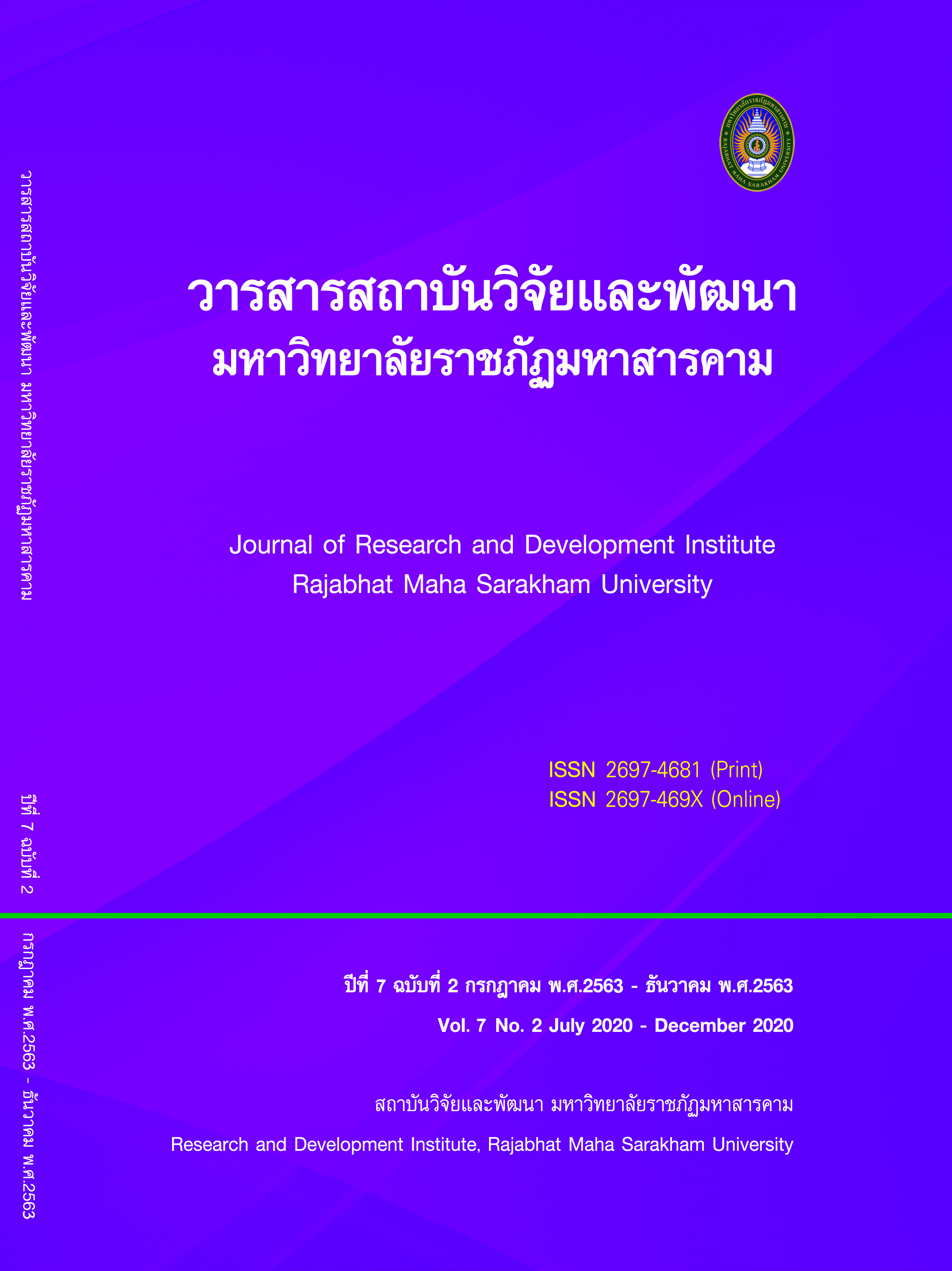การพัฒนาการจัดกิจกรรมการเรียนรู้เรื่องสถิติ โดยใช้เทคนิค KWDL สำหรับนักเรียนชั้นมัธยมศึกษาปีที่ 1
คำสำคัญ:
การจัดกิจกรรมการเรียนรู้, เทคนิค KWDL, ความพึงพอใจบทคัดย่อ
การวิจัยมีวัตถุประสงค์เพื่อ 1) พัฒนากิจกรรมการเรียนรู้เทคนิค KWDL เรื่องสถิติ สำหรับนักเรียนชั้นมัธยมศึกษาศึกษาปีที่ 1 ที่มีประสิทธิภาพตามเกณฑ์ 80/80 2) เปรียบเทียบผลสัมฤทธิ์ทางคณิตศาสตร์โดยการเรียนรู้เทคนิค KWDL เรื่องสถิติ ของนักเรียนชั้นมัธยมศึกษาปีที่ 1 เทียบกับเกณฑ์ร้อยละ 80 3) ศึกษาความสามารถด้านการแก้ปัญหาทางคณิตศาสตร์เรื่องสถิติ โดยการเรียนรู้เทคนิค KWDL ของนักเรียนชั้นมัธยมศึกษาปีที่ 1 และ 4) ศึกษาความพึงพอใจของนักเรียนที่มีต่อการเรียนด้วยการจัดกิจกรรมการเรียนรู้เทคนิค KWDL เรื่องสถิติ กลุ่มตัวอย่างที่การวิจัยนักเรียน
ชั้นมัธยมศึกษาปีที่ 1/8 เครื่องมือที่การวิจัย 1) แผนการจัดการเรียนรู้ 2) แบบทดสอบวัดผลสัมฤทธิ์ทางการเรียน 3) แบบวัดความสามารถด้านการแก้ปัญหาทางคณิตศาสตร์ 4) แบบวัดความพึงพอใจของนักเรียน สถิติที่ใช้ในการวิเคราะห์ข้อมูลคือ ค่าร้อยละ ค่าเฉลี่ย ค่าเบี่ยงเบนมาตรฐาน และ t – test (Dependent samples)
ผลการวิจัย 1) แผนการจัดการเรียนรู้เทคนิค KWDL เรื่อง สถิติ ชั้นมัธยมศึกษาปีที่ 1 ที่มีประสิทธิภาพ (E_1/E_2) เท่ากับ 84.07/80.93 สูงกว่าเกณฑ์ที่ตั้งไว้ 2) นักเรียนชั้นมัธยมศึกษาปีที่ 1 ที่เรียนโดยใช่การจัดกิจกรรมการเรียนรู้เทคนิค KWDL มีผลสัมฤทธิ์ทางการเรียนหลังเรียนสูงกว่าก่อนเรียนอย่างมีนัยสำคัญทางสถิติที่ระดับ .05 3) นักเรียนมีความสามารถด้านการแก้ปัญหาทางคณิตศาสตร์เรื่อง สถิติ โดยการเรียนรู้เทคนิค KWDL อยู่ในระดับดีเยี่ยม 4) นักเรียนมีความพึงพอใจต่อการเรียนด้วยแผนการจัดกิจกรรมการเรียนรู้เทคนิค KWDL โดยมีความพึงพอใจอยู่ในระดับพึงพอใจมาก
เอกสารอ้างอิง
References
Chayanisa Pengjan, Noppon Tanachaikhan and Sudapron Panyapreuk. (2017). THE LEARNING MANAGEMENT BY USING KWLD TECHNIQUE TO DEVELOP LEARNING ACHIEVEMENT IN MATHEMATICS ENTITLE “SENTENCE PROBLEMS” OF PRATHOMSUKSA 6 STUDENTS. Journal of Graduate Research, 8 (1), 71-82.
Jirapa Nuchthongmuang. (2015). THE DEVELOPMENT OF MATHEMATIC ACHIEVEMENT ON AREAS USING GEOBOARD AND INQUIRY CYCLE (5E) FOR PRATHOMSUKSA 4 OF SAWANGWITTAYA SCHOOL. Master of Education Thesis: Silpakorn University.
Jutawat Sriphanlum (2015). A Study of Learning Achievement in Mathematics on the Topic of Addition and Subtraction for 3 Grade by Using KWDL Learning Technique and Normal Learning. Master's Degree Thesis (Curriculum and Instruction): Maha Sarakham Rajabhat University.
Maslow, A. (1970). Motivation and Personality. 2nd ed. New York: Harpers and Row.
Ministry of Education. (2008). Basic Education Core Curriculum 2008.
Bangkok: Ministry of Education
Ministry of Education. (2009). Basic core courses. Bangkok: Ministry of Education.
National Institute of Educational Testing (Public Organization). (2018). Report of the results of the National Basic Educational Test (O-NET) Academic Year 2018. [Online] http://www.onetresult.niets.or.th/AnnouncementWeb/Login.aspx [1 August 2019].
Nuttawut Buttawong. (2017). Development of teaching and learning activities in mathematics by collaborative learning activities using TAI techniques, basic statistics and probability, Prathomsuksa 6, Pongploy Anusorn School. Bangkok (Huamark).
Pongnapha Jaitha (2015). Development of mathematics learning achievement of grade 4 students using KWDL technique. Master of Education Thesis (Curriculum and Instruction): Maha Sarakham Rajabhat University.
Puangpet Kwoaplod. (2013). Development of mathematics learning achievement on the application of single variable linear equations by using a set of problem-solving activities based on the concept of Polya of Mathayom Suksa 2 students, Muang Nakhon Si Thammarat School. Mahasarakham: Mahasarakham University.
Shaw Chambless and Chessin Price. (1997). “Cooperative Problem Solving: Using K-W-D-L as an Organizational Technique”. Teaching Children Mathematics, 3(9), 482-486.
Tisana Khammani. (2012). Pedagogical Sciences: Knowledge for effective organization of learning processes. Bangkok: Chulalongkorn University.
Watchara Laowreandee. (2011). Models and strategies of learning management for the development of thinking. 7th edition. Nakhon Pathom: Silpakorn University.
ดาวน์โหลด
เผยแพร่แล้ว
รูปแบบการอ้างอิง
ฉบับ
ประเภทบทความ
สัญญาอนุญาต
บทความที่ได้รับการตีพิมพ์เป็นลิขสิทธิ์เป็นของผู้ประพันธ์บทความ







